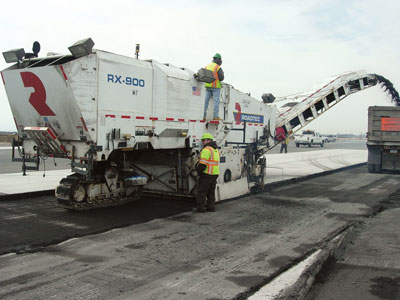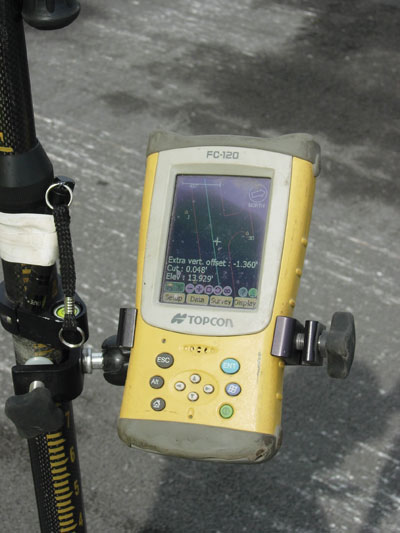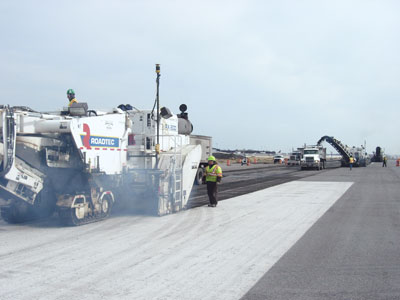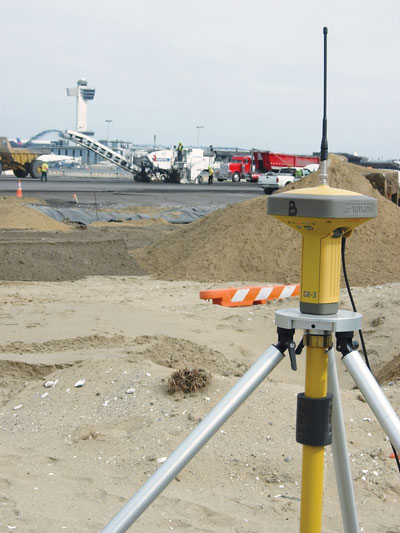
Features
Investments
Roads & Paving
Paving for Performance
A high-profile runway resurfacing project at New York’s JFK airport puts advanced milling control
June 18, 2012 By Don Talend
ank Sinatra once sang that if you can make it in New York, you can make
it anywhere. Advanced milling and grading technology recently was tested
according to that old adage at John F. Kennedy (JFK) International
Airport and passed the test impressively.
Frank Sinatra once sang that if you can make it in New York, you can make it anywhere. Advanced milling and grading technology recently was tested according to that old adage at John F. Kennedy (JFK) International Airport and passed the test impressively.
 |
|
| Conditions forced Intercounty Paving to mill the existing surface in two steps: bulk milling to within about an inch and a half and fine milling to within two-hundredths of a foot. (Photo by Don Talend)
|
JFK’s 13R-31L (Bay) Runway – the nation’s third-longest at 14,572 feet – was resurfaced with an 18-inch layer of concrete to yield an expected maintenance savings of $500 million over an expected 40-year life span, compared with an anticipated eight-year asphalt life span. Because JFK is a key component in the nation’s commercial air-traffic system, the first phase of the $376.3 million project was put on a fast-track schedule of 120 days, with overall completion due in late 2011. In addition to financing from the owner, the Port Authority of New York and New Jersey, the project received $73 million from the Federal Aviation Administration and $15 million in American Recovery and Reinvestment Act funding.
Milling, grading and paving subcontractor Intercounty Paving Associates, LLC of Hicksville, N.Y., kept the first milling phase of this first phase on track by simultaneously utilizing a combination laser-Global Navigation Satellite System (GNSS) on multiple Roadtec RX-900 cold planers.
Preventing chronic delays
JFK has traditionally experienced problems with delays. According to the U.S. Department of Transportation, it ranked 28th out of 31 major airports in on-time performance in 2009. The Bay runway is a key component of JFK’s infrastructure, handling about one-third of its annual operations and more than half of all departures, to the tune of about 440,000 flights and 48 million passengers in 2008.
 |
|
| Satellite and laser readings were displayed on an FC-120 field controller. (Photo by Don Talend) |
To address the chronic delays the general contractor, Sylmar, Calif.-based Tutor Perini, was awarded a $204-million contract to widen the runway from 150 to 200 feet to allow for new delay-reduction taxiways. The new shoulders along either side of the widened runway are 50 feet wide and sit adjacent to 30-foot-wide erosion pavement. The runway will be the first to accommodate the massive new Airbus A-380 and also serve as a backup landing spot for the space shuttle. All of these changes are designed to improve aircraft queuing, and allow quicker departures and easier access between taxiways and terminal gates.
While the resurfacing was underway, traffic was diverted to JFK’s three smaller runways, and longer queues resulted. Part of the Bay Runway had to remain open to traffic so that planes could taxi across the open portion between the terminals and the other runways. After the first phase, about 11,000 feet of the runway was to be reopened and the remaining 4,000 feet-plus was to be resurfaced in subsequent stages.
The March 1 to July 1 schedule for the first phase was chosen because the period is the driest in the New York area, according to the Newark Star-Ledger. The alternative, the newspaper reported, was night work that would have taken two to three years.
Procedural changes work out
Preparations began during night closures the month before the start date. Tutor Perini surveyors George and Tom Harris localized the job site using Intercounty’s GR-3 base station from Topcon Positioning Systems. The GR-3’s one-watt UHF radio left dead zones at both ends of the runway, typical in radio signal-dense airfield environments. So the Harris brothers set up Topcon’s 35-watt external radio, allowing them to position the base station along the runway, near the middle of the job site, and providing full radio coverage without interference from voice traffic. Also complicating matters were several unseasonably heavy snowfalls during February. Once control points were located, they had to be cleared before the shots could be taken and drifting snow routinely refilled the control point holes.
 |
|
| The rough-milling cold planers prepared the surface in a staggered formation. (Photo by Don Talend) |
These weather conditions would have made the conventional method of gridding and marking out the runway in time for early March milling difficult to impossible, making it clear that an alternative method of elevation control would be beneficial.
Despite the fact that Intercounty made adjustments on its Roadtec cold planers to allow for unexpected issues with the lasers, the system turned out to be invaluable for milling efficiency. The system made an initial impact in sub grade preparation and increasingly is being used for milling and paving. Just as Millimeter GPS+ has been used for fine grading, contractors are beginning to use it for fine milling, achieving accuracies within a quarter-inch, in contrast to the tenth-of-a-foot precision inherent in conventional machine control.
Millimeter GPS+ combines GNSS and laser. In addition to a GNSS base and rover, the system uses a PZL-1 Lazer Zone transmitter and a PZS-MC machine-control sensor or PZS-1 rover sensor that gets integrated with the contractor’s GNSS receiver. The PZL-1 transmitter sends out a wall of laser light 33 feet tall and up to 2,000 feet in diameter. The contractor can link up to four transmitters for a total reach of 8,000 horizontal feet and 132 vertical feet. The PZL-1 transmitter can operate multiple machines equipped to accept its signals. The GNSS component of the system plots the location of the machine while the laser component guides the grader to position and elevates the blade precisely. The system understands the three-dimensional position of the laser transmitter and the three-dimensional position of the machine, and is then able to calculate the vertical angle from the laser up to the sensor on the machine and provide a vertical correction.
The roughly 12,000-foot runway was divided into quadrants about 6,000 feet long and 200 feet wide from the centreline. The 200-foot widths were subdivided into two adjacent 100-foot-wide subsections to accommodate eight passes by the 12-1/2-foot-wide Roadtecs. With the entire job now accurately localized for GPS at its midpoint with a single control point file, Intercounty’s project supervisor, Jim Egerter, figured that mounting the PZL-1s on 15-foot-tall towers would provide the lasers with continuous coverage. But nonstop 40-mph-plus winds would not allow continuous rotation of the self-leveling Topcon PZL-1 lasers at that height.
 |
|
| A 35-watt external radio was set up near the Topcon GR-3 base station to boost radio reception in an environment characterized by heavy radio interference. (Photo by Don Talend)
|
So Jim Cleary of Intercounty’s Topcon dealer, Cleary Machinery Co., Inc., South Bound Brook, N.J., lowered the PZL-1s to their standard two-metre height on tripods. Intercounty had five milling machine rovers and three survey rovers all corrected by a single base station despite being located thousands of feet apart. A three-dimensional site model developed by Mesh Consulting, Eagleville, Pa., was loaded into the Roadtec’s machine-control systems. The original plan was to fine-mill the surface to within three-quarters of an inch of the specified elevation in a single pass using three machines deployed in a staggered formation. The machine making the virgin cut would have Millimeter GPS+ controlling both sides of the drum. Each trailing machine would joint match on one side using the RX-900’s hydromation system, while utilizing Millimeter GPS+ on the other side. Four PZL-1s were spaced apart by 750 feet, affording a pass length of 3,000 feet before the machines would have to square up and return to original starting point.
The equipment blockages and weather caused the Roadtecs to cut to within 0.02 feet with laser reception and within 0.05 feet without it. These factors, coupled with severe machine vibration caused by the deep cut in hard material, made precisely milling to the specified elevation in one pass difficult, forcing Egerter and Intercounty’s milling superintendent, Joe La Placa, to devise an alternative process that proved to be even more efficient than the original plan.
The decision was made to disconnect the laser receivers on three of the Roadtecs and have them rough-mill the existing surface to an inch and a half above finished sub grade. Egerter and La Placa reasoned that since the machines were going to cut the last lift with the Millimeter GPS+ anyway, the rough-mill accuracy was not as critical. Three machines cutting without the lasers actually put Intercounty ahead of schedule and two other Roadtecs fine-milled where possible at any given time.
Occasionally Cleary got out of his pickup truck to check the elevation behind one of the Millimeter GPS-equipped Roadtecs with a combination GR-3 antenna and PZS-1 sensor. The FC-120 field controller also mounted on the pole listed the elevation in feet and the cut in thousandths of an inch. Cleary levelled the pole, checked the FC-120 readout, rotated the PZS-1 sensor toward the PZL-1 transmitter and verified laser reception, following the machine and resetting the pole about every 200 feet. He was looking for cuts within 0.02 feet and generally obtained readings within that tolerance. The fine-milling machines were set at 18 inches (minus 1.50 feet) and the bulk-milling machines were set at 16-1/4 inches (minus-1.36 feet). Egerter noted that, after the rough start, Intercounty was hitting the daily production goal of 2,000 by 100 feet.
Continuous accuracy
“You could almost say that GPS isn’t any more accurate than manual at station, but between stations, it is,” Cleary pointed out. “It performs like a virtual string line, calculating smooth transitions from station to station. And it eliminates the occasional blown grade.”
“That’s right,” added La Placa, echoing the greater continuity that was possible with the new system. “Plus, there’s no human error factor. It’s like a computer – garbage in, garbage out; if you put the correct information in, the correct information will come out. The fact of the matter is, you can have all of this fancy equipment and it’s really not going to make the ride any better unless you know how to mill. But this system takes the human error out and it’s working really well the way we’re using it. It’s almost the opposite of paving with asphalt, where you put down your base and binder course and then you come back and try to get everything levelled up to a consistent final lift and then you come back and top it. The more consistent the lift depths are, the better the ride is going to be and that’s what we’re doing here.”
“The entire area was milled without a single mark on the ground, which is roughly 8,000-plus shots in a 25-by-12-foot grid over 11,000-plus feet,” Cleary concluded. “You could assume that two cuts would have been required with any other method, given the hardness of the surface. The mark-out costs associated with 16,000 shots are actually insignificant compared with the potential downtime resulting from waiting for the marks to be made, due to the large penalties enforced for not finishing the job on time. When you consider increased machine productivity and the concrete material savings the accurate milling provided, you could say that these contractors reaped the same benefits that GPS machine control has been providing grading and excavation contractors for the past decade.”
Don Talend of Write Results Inc., West Dundee, Ill., is a print and e-content developer specializing in construction, technology and innovation.
Print this page